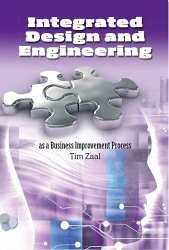 Tim
Zaal
Tim
Zaal
Maj Engineering Publishing, February 2009
 Tim
Zaal
Tim
Zaal
Maj Engineering Publishing, February 2009
ISBN 9079182036 (paper)
Buy it from Amazon.com (commission paid)
Buy it from Amazon.co.uk (commission paid)
Zaal is a lecturer at the University of Utrecht, in the manufacturing industry-facing department of integrated design. He has written a tidy, clear, well-produced small book of about 200 pages on the business processes and thinking involved. No prior knowledge is assumed of the reader, so the book is suitable for students and for practitioners new to the subject. The exposition and worked examples are built up in easy stages to provide a wide understanding of manufacturing design processes.
The chapter topics flow smoothly from Why IDE? to the IDE Philosophy - team working and concurrent engineering; then Structure Models for Product Data Management and Reuse of Knowledge (i.e. requirements definition), Mapping the Client's Demands and Wishes (i.e. trade-offs), Methodology for Product Design over the Life Cycle, and then two strong chapters covering production, operation and maintenance.
Readers familiar with the software, systems and requirements engineering literature will find that manufacturing industry has developed its own effective ways of coping with the problems of design of small to medium-sized products.
For example, terms like goal, requirement, scenario, system are barely used. Systems Engineering itself is acknowledged (page 49) to be a useful practice with much in common with integrated design and engineering (IDE), for complex projects "where a lot of companies work together". The business/user requirements document is called simply "the PDF Document" implying, perhaps, that it is the one fixed point for design; however Zaal states clearly that it "includes all the client wishes about the (new) product" (page 90). Qualities, Constraints and for that matter Non-Functional Requirements are not mentioned, but there are good sections on design for "long life service", sustainability and reuse, production costs and so on. Safety and security are not discussed, but there is a good practical account of reliability engineering, including the use of FMEA. In other words, the book is strongest just where software books are weakest.
Zaal advocates functional decomposition (FD) with IDEF-0, ignoring the criticism heaped on FD and dataflow by the software world. Wholly "new" modelling notations emerge: FD is visualized using "Hamburger models" - each node in the hierarchy is drawn as a bun where the functional specification (say, 800 litres/minute) is sandwiched between two curved halves of a bread roll, the upper being the function ("Transport Liquid") and the lower being the solution ("Centrifugal Pump"). You can see that this conveniently marries a business goal at the top, a system specification in the middle, and a design solution at the bottom - in a simple practical notation. To the critics who'd argue that this seems to jump the gun in assigning solutions to problems, Zaal immediately replies
"Also with the Hamburger model it is possible to produce an overview of all the possible solutions, or variations in solutions, in one model."
In other words, it is not just a goal-and-solution hierarchy; it permits alternatives, presumably diagrammed as alternative decompositions. And the book is extremely clear on the task of trading-off such alternatives, which Zaal calls "mapping the client's demands and wishes" [to design options]. The principal method is QFD (Quality Function Deployment) with House of Quality, which is applied in full detail and very clearly explained. I personally don't trust QFD's reliance on mechanical weighting of the different factors (see Discovering Requirements); but then, weighting is just as widespread in software and systems engineering as it seems to be in integrated design.
Practitioners and students of integrated design will find Zaal clear, helpful and accurate throughout. The book is easy to read and has helpful exercises with answers at the back. The book is well indexed. Overall this book is an excellent introduction, and a fascinating insight into the world of product design.
(c) Ian Alexander 2009
You may also like: